
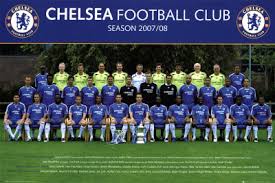 |  | 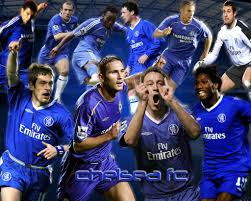 | 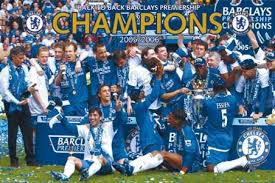 | 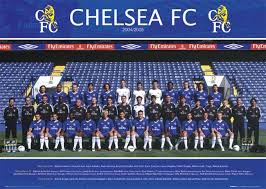 |

English Premier League
England
The Barclays English Premier League (EPL), considered as the best in the world.
Birmingham City vs Chelsea
Official name Birmingham City FC
City Birmingham
Founded 1875
Club colors Blue / White / White
vs.
0 - 0
Chelsea
Official name Chelsea FC
City London
Founded 1905
Club colors Blue / Blue / White
Match scheduled:
Date: 26-12-2009
Time: 12:45 until 14:45
Week 19 / Round 19 :: Barclays Premier League 2009/2010

Small Heath Alliance played their first home games on waste ground off Arthur Street, Bordesley Green. As interest grew, they moved to a fenced-off field in Ladypool Road, Sparkbrook, where admission could be charged. A year later, they moved again, to a field adjoining Muntz Street, Small Heath, near the main Coventry Road, with a capacity of about 10,000. Muntz Street was adequate for 1880s friendly matches, and the capacity was gradually raised to around 30,000, but when several thousand spectators scaled walls and broke down turnstiles to get into a First Division match against Aston Villa, it became clear that it could no longer cope with the demand.[64]
Director Harry Morris identified a site for a new ground in Bordesley Green, some three-quarters of a mile (1 km) from Muntz Street towards the city centre. The site was where a brickworks once operated; the land sloped steeply down to stagnant pools, yet the stadium was constructed in under twelve months from land clearance to opening ceremony on Boxing Day 1906. Heavy snow nearly prevented the opening; volunteers had to clear pitch and terraces before the match, a goalless draw against Middlesbrough, could go ahead.[64] The ground is reputed to have been cursed by gypsies evicted from the site;[65] although gypsies are known to have camped nearby,[66] there is no contemporary evidence for their eviction by the club.
The original capacity of St Andrew's was reported as 75,000, with 4,000 seats in the Main Stand and space for 22,000 under cover.[64] By 1938 the official capacity was 68,000, and February 1939 saw the attendance record set at the fifth round FA Cup tie against Everton, variously recorded as 66,844 or 67,341.[B] On the outbreak of the Second World War, the Chief Constable ordered the ground's closure because of the danger from air-raids; it was the only ground to be thus closed, and was only re-opened after the matter was raised in Parliament. It was badly damaged during the war, the Railway End and the Kop as a result of bombing, the Main Stand burnt down when a fireman mistook petrol for water.[64]
The replacement Main Stand used a propped cantilever roof design, which meant fewer pillars to block spectators' view of the pitch. Floodlights were installed in 1956, and officially switched on for a friendly match against Borussia Dortmund in 1957.[67] By the early 1960s a stand had been built at the Railway End to the same design as the Main Stand, roofs had been put on the Kop and Tilton Road End, and the ground capacity was down to about 55,000.[67]
Resulting from the 1986 Popplewell report into the safety of sports grounds and the later Taylor Report, the capacity of St Andrew's was set at 28,235 for safety reasons,[29][67] but it was accepted that the stadium had to be brought up to modern all-seated standards. After the last home game of the 1993–94 season, the Kop and Tilton Road terraces were demolished – with fans taking home a significant proportion as souvenirs – to be replaced at the start of the new season by a 7,000-seat Tilton Road Stand, continuing round the corner into the 9,500-seat Kop which opened two months later.[64] The 8,000-seat Railway Stand followed in 1999,[68] but the Main Stand has still to be modernised.
In 2004 a proposal was put forward to build a "sports village" comprising a new 55,000 capacity stadium for the club, to be known as the City of Birmingham Stadium, other sports and leisure facilities, and a super casino. The project would be jointly financed by Birmingham City Council, Birmingham City F.C. (via the proceeds of the sale of St Andrew's) and the casino group Las Vegas Sands. The feasibility of the plan depended on the government issuing a licence for a super casino, and Birmingham being chosen as the venue,[69] but this did not happen. The club have planning permission to redevelop the Main Stand,[70] but club and council have continued to seek alternative sources of funding for the City of Birmingham Stadium project.[71]
Birmingham fans consider their main rivals to be Aston Villa, their nearest neighbours geographically, with whom they contest the Birmingham derby. Lesser rivalries exist with fellow West Midlands clubs Wolverhampton Wanderers and West Bromwich Albion. According to a 2003 Football Fans Census survey, Aston Villa fans think of Birmingham City as their main rivals, though this has not always been the case.[72]
The fans are referred to as Bluenoses, a nickname attributed by the Football Fans Census survey to an "accusation they are left out in the cold when it comes to success".[72] Ondré Nowakowski's Sleeping Iron Giant, a piece of public sculpture in the form of a ten-times-life-size head lying on a mound near the St Andrew's ground, has been repeatedly defaced with blue paint on its nose.[73][74] Between 1994 and 1997 the club mascot took the form of a blue nose,[75] though it is now a dog called Beau Brummie, a play on the name Beau Brummell and Brummie, the slang word for a person from Birmingham.
There are a number of supporters' clubs affiliated to the football club, both in England and abroad.[76] While an action group was formed in 1991 to protest against chairman Samesh Kumar,[31] the club blamed an internet petition for the collapse of the purchase of player Lee Bowyer in 2005,[77] and antipathy towards the board provoked hostile chanting and a pitch invasion after the last match of the 2007–08 season,[78][79] relations between club and fanbase have never been so poor as to provoke the formation of an independent supporters' group. When the club was in financial difficulties, supporters contributed to schemes which funded the purchase of players Brian Roberts in 1984[80] and Paul Peschisolido in 1992.[31]
There have been several fanzines published by supporters; in 2008, two were regularly on sale, Made in Brum, first issued in 2000, and the longer-established Zulu. The hooligan firm associated with the club, the Zulus, were unusual in that they had multi-racial membership at a time when many such firms had associations with racist or right-wing groups.[81][82] The 2005 film Green Street features hooliganism surrounding a fictional match between West Ham United and Birmingham.
The fans' anthem,[83] an adaptation of Harry Lauder's Keep right on to the end of the road,[84] was adopted during the 1956 FA Cup campaign. The Times' football correspondent described in his Cup Final preview how
the Birmingham clans swept their side along to Wembley – the first side ever to reach a final without once playing at home – on the wings of the song "Keep right on to the end of the road".[85]
Player Alex Govan is credited with popularising the song, by singing it on the coach on the way to the quarter final,[86] and when he revealed in an interview that it was his favourite.
In the build-up to the 1956 FA Cup semi-final with Sunderland I was interviewed by the press and happened to let slip that my favourite song was Harry Lauder's old music hall number "Keep Right on to the End of the Road". I thought no more about it, but when the third goal went in at Hillsborough the Blues fans all started singing it. It was the proudest moment of my life.[87]

Chelsea were founded on 14 March 1905 at The Rising Sun pub (now The Butcher's Hook), opposite the present-day main entrance to the ground on Fulham Road, and were elected to the Football League shortly afterwards. The club's early years saw little success; the closest they came to winning a major trophy was reaching the FA Cup final in 1915, where they lost to Sheffield United. Chelsea gained a reputation for signing big-name players[7] and for being entertainers, but made little impact on the English game in the inter-war years.
Former Arsenal and England centre-forward Ted Drake became manager in 1952 and proceeded to modernise the club. He removed the club's Chelsea pensioner crest, improved the youth set-up and training regime, rebuilt the side, and led Chelsea to their first major trophy success – the League championship – in 1954–55. The following season saw UEFA create the European Champions' Cup, but after objections from The Football League and the FA Chelsea were persuaded to withdraw from the competition before it started.[8]

The 1960s saw the emergence of a talented young Chelsea side under manager Tommy Docherty. They challenged for honours throughout the decade, and endured several near-misses. They were on course for a treble of League, FA Cup and League Cup going into the final stages of the 1964–65 season, winning the League Cup but faltering late on in the other two.[9] In three seasons the side were beaten in three major semi-finals and were FA Cup runners-up. In 1970 Chelsea were FA Cup winners, beating Leeds United 2–1 in a final replay. Chelsea took their first European honour, a UEFA Cup Winners' Cup triumph, the following year, with another replayed win, this time over Real Madrid in Athens.
The late 1970s and the 1980s were a turbulent period for Chelsea. An ambitious redevelopment of Stamford Bridge threatened the financial stability of the club,[10] star players were sold and the team were relegated. Further problems were caused by a notorious hooligan element among the support, which was to plague the club throughout the decade.[11] In 1982 Chelsea were, at the nadir of their fortunes, acquired by Ken Bates for the nominal sum of £1, although by now the Stamford Bridge freehold had been sold to property developers, meaning the club faced losing their home.[12] On the pitch, the team had fared little better, coming close to relegation to the Third Division for the first time, but in 1983 manager John Neal put together an impressive new team for minimal outlay. Chelsea won the Second Division title in 1983–84 and established themselves in the top division, before being relegated again in 1988. The club bounced back immediately by winning the Second Division championship in 1988–89.
After a long-running legal battle, Bates reunited the stadium freehold with the club in 1992 by doing a deal with the banks of the property developers, who had been bankrupted by a market crash.[13] Chelsea's form in the new Premier League was unconvincing, although they did reach the FA Cup final in 1994. It was not until the appointment of former European Footballer of the Year Ruud Gullit as player-manager in 1996 that their fortunes changed. He added several top-class international players to the side, as the club won the FA Cup in 1997 and established themselves as one of England's top sides again. Gullit was replaced by Gianluca Vialli, who led the team to victory in the League Cup and the Cup Winners' Cup in 1998, the FA Cup in 2000 and the UEFA Champions League quarter-finals in 2000. Vialli was sacked in favour of another Italian, Claudio Ranieri, who guided Chelsea to the 2002 FA Cup Final and Champions League qualification in 2002–03.

In June 2003, Bates sold Chelsea to Russian billionaire Roman Abramovich for £140 million, completing what was then the biggest-ever sale of an English football club.[3] Over £100 million was spent on new players, but Ranieri was unable to deliver any trophies, so he was replaced by Portuguese coach José Mourinho. Under Mourinho, Chelsea became the fifth English team to win back-to-back league championships since the Second World War (2004–05 and 2005–06),[14] in addition to winning an FA Cup (2007) and two League Cups (2005 and 2007). In September 2007 Mourinho was replaced by Avram Grant,[15] who led the club to their first UEFA Champions League final, in which they lost on penalties to Manchester United. Grant was sacked days later[16] and succeeded by Luiz Felipe Scolari in July 2008.[17]
Scolari spent only seven months in the job before being dismissed after a string of poor results.[18] Russia coach Guus Hiddink was appointed caretaker manager until the end of the 2008–09 season.[19] Chelsea's season ended with a 2–1 win over Everton in the FA Cup Final.[20] Two days later former AC Milan coach Carlo Ancelotti was confirmed as Chelsea's new manager.[21]
Stamford Bridge
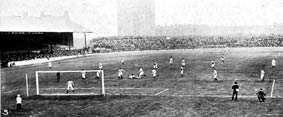
Chelsea have only ever had one home ground, Stamford Bridge, where they have played since foundation. It was officially opened on 28 April 1877. For the first 28 years of its existence it was used almost exclusively by the London Athletics Club as an arena for athletics meetings and not at all for football. In 1904 the ground was acquired by businessman Gus Mears and his brother Joseph, who had previously acquired additional land (formerly a large market garden) with the aim of staging football matches on the now 12.5 acre (51,000 m²) site.[22]
Stamford Bridge was designed for the Mears family by the noted football architect Archibald Leitch.[23] They offered to lease the stadium to Fulham Football Club, but the offer was turned down. As a consequence, the owners decided to form their own football club to occupy their new ground. Most football clubs were founded first, and then sought grounds in which to play, but Chelsea were founded for Stamford Bridge. Since there was already a football club named Fulham in the borough, the founders decided to adopt the name of the adjacent borough of Chelsea for the new club, having rejected names such as Kensington FC, Stamford Bridge FC and London FC.[24]
Starting with an open bowl-like design and one covered terrace, Stamford Bridge had an original capacity of around 100,000.[22] The early 1930s saw the construction of a terrace on the southern part of the ground with a roof that covered around one fifth of the stand. It eventually became known as the "Shed End", the home of Chelsea's most loyal and vocal supporters, particularly during the 1960s, 70s and 80s. The exact origins of the name are unclear, but the fact that the roof looked like a corrugated iron shed roof played a part.[22]
During the late 1960s and early 70s, the club's owners embarked on a modernisation of Stamford Bridge with plans for a 50,000 all-seater stadium.[22] Work began on the East Stand in the early 1970s but the project was beset with problems and the cost almost brought the club to its knees, culminating in the freehold being sold to property developers. Following a long legal battle, it was not until the mid-1990s that Chelsea's future at the stadium was secured and renovation work resumed.[22] The north, west and southern parts of the ground were converted into all-seater stands and moved closer to the pitch, a process completed by 2001.
When Stamford Bridge was redeveloped in the Ken Bates era many additional features were added to the complex including two hotels, apartments, bars, restaurants, the Chelsea Megastore, and an interactive visitor attraction called Chelsea World of Sport. The intention was that these facilities would provide extra revenue to support the football side of the business, but they were less successful than hoped and before the Abramovich takeover in 2003 the debt taken on to finance them was a major burden on the club. Soon after the takeover a decision was taken to drop the "Chelsea Village" brand and refocus on Chelsea as a football club. However, the stadium is sometimes still referred to as part of "Chelsea Village" or "The Village".
The Stamford Bridge pitch, the freehold, the turnstiles and Chelsea's naming rights are now owned by Chelsea Pitch Owners, a non-profit organisation in which fans are the shareholders. The CPO was created to ensure the stadium could never again be sold to developers. It also means that if the club moves to a new location, they could not use the Chelsea FC name.[25]
The club plans to increase its capacity to over 50,000. Owing to its location in a built-up part of London on a main road and next to two railway lines, fans can only enter the stadium through the Fulham Road entrance, which places severe constraints on expansion due to health and safety regulations.[26] As a result, Chelsea have been linked with a move away from Stamford Bridge to sites including the Earls Court Exhibition Centre, Battersea Power Station and the Chelsea Barracks.[27] However, the club have reiterated their desire to keep Chelsea at their current home.[28]
Chelsea's training ground is located in Cobham, Surrey. Chelsea moved to Cobham in 2004. Their previous training ground in Harlington was taken over by QPR in 2005.[29] The new training facilities in Cobham were completed in 2007.[30]
Crest

Since the club's foundation, Chelsea have had four main crests, though all underwent minor variations. In 1905, Chelsea adopted as their first crest the image of a Chelsea pensioner, which obviously contributed to the "pensioner" nickname, and remained for the next half-century, though it never appeared on the shirts. As part of Ted Drake's modernisation of the club from 1952 onwards, he insisted that the pensioner badge be removed from the match day programme in order to change the club's image and that a new crest be adopted.[31] As a stop-gap, a temporary emblem comprising simply the initials C.F.C. was adopted for one year.
In 1953, Chelsea's crest was changed to an upright blue lion looking backwards and holding a staff, which was to endure for the next three decades. This crest was based on elements in the coat of arms of the Metropolitan Borough of Chelsea[32] with the "lion rampant regardant" taken from the arms of then club president Viscount Chelsea and the staff from the Abbots of Westminster, former Lords of the Manor of Chelsea. It also featured three red roses, to represent England, and two footballs. This was the first club badge to appear on shirts, since the policy of putting the crest on the shirts was only adopted in the early 1960s.[31]
 | 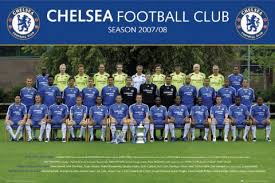 | 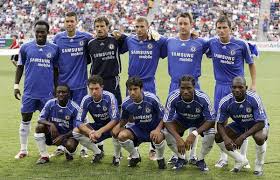 |  |  |










